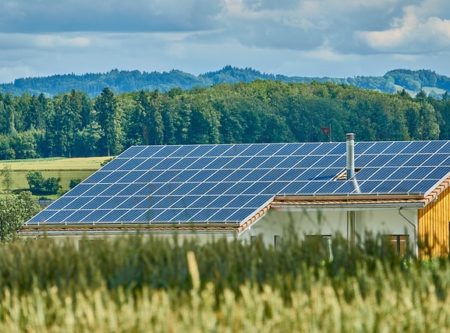In France, housing accounts for around 20% of greenhouse gas emissions. In a world focused on sustainability and ecology, adopting eco-responsible practices in our homes is becoming essential. More and more French people are convinced of the benefits of the energy transition and are embracing a lifestyle that is more respectful of the planet. Use of natural materials, zero waste, insulation work, sustainable consumption… Discover our tips for making your home greener.
Our golden rules for a greener home
1. Optimize your home’s insulation
To improve the energy performance of your property, it’s essential to carry out renovation work to strengthen its insulation. This will reduce heat loss in winter and keep the house cooler in summer. You need to think about improving roof insulation (25-30% of heat loss is through the roof), wall insulation, window insulation (which accounts for 10-15% of heat loss) and low-floor insulation (which accounts for 7-10% of energy loss). Don’t forget to install a good ventilation system to renew the air in your rooms and keep them healthy. Double-flow CMV is recommended.
Ideally, you should also choose sustainable insulation materials to limit your carbon footprint, such as wood, sheep’s wool, cork, cellulose wadding or hemp concrete.
Good to know: under certain conditions, energy renovation work can qualify for financial assistance: the “coup de pouce chauffage” scheme, zero interest eco-loans (Eco-PTZ), the 5.5% VAT rate, MaPrimeRénov, local grants, etc.
2. Choose eco-friendly materials and renewable energy sources
To create a healthier, greener living space, opt for environmentally-friendly materials and renewable energy sources to limit your carbon footprint. Theselogement-ecologiqe-panneaux-
For energy production, photovoltaic panels are an excellent alternative. By capturing energy, they can power all the equipment in a home. There are also domestic wind turbines, but due to their high cost and strict local regulations, they are not widely used.
For heating, heat pumps are widely used. They heat a dwelling by capturing the calories present in the environment: in the air, in water or in the earth. Heat pumps produce more energy than they consume. You may also want to consider a green energy supplier, who will provide you with electricity from renewable sources such as wind, hydro, geothermal and solar power.
Then, for your renovations or refurbishments, we recommend you turn to eco-friendly materials such as FSC-certified wood, VOC (volatile organic compound)-free paints, bamboo flooring, recycled steel, aerated concrete…
3. Opt for energy-efficient appliances
Start by replacing your traditional light bulbs with energy-efficient LED bulbs. Not only do they consume considerably less energy, they also last longer.
Also, when it’s time to replace your appliances, choose Energy Star-certified models. They are designed to be more energy-efficient, reducing your consumption and your impact on the environment. In the long term, all these habits will help reduce your energy bill and make your home greener. You should also consider buying A++ and A+ energy-class equipment.
As for your heating system, it must be able to combine performance and respect for the environment, while preserving natural resources. To achieve this, we recommend installing a wood-burning stove, a pellet-fired boiler or an air/water heat pump.
4. Adopt sustainable living habits
To promote this energy transition, it’s essential to adopt eco-responsible gestures to minimize your environmental footprint.
Choose natural cleaning products: baking soda, white vinegar, black soap, Marseille soap… You can also make your own cosmetics and cleaning products.
Choose durable rather than disposable items: opt for reconditioned products, glass jars rather than plastic bags, cloth make-up remover discs rather than cotton pads…
Limit your water consumption or reclaim it: you can use a low-flow shower head, install a rainwater recovery system, repair your water leaks, install low-flow toilet flushes…
Focus on zero waste: set up a selective sorting policy in your home by placing recycling bins, favor products with minimalist packaging such as bulk products, install a compost in your garden, avoid buying plastic bottles…In the long term, all these actions add up to make a big difference for the environment.
5. Turn your home into a smart home
Home automation is a fast-growing phenomenon. Connected objects, artificial intelligence, home automation – for a long time, these systems were reserved for the well-off because of their high
Home automation can be an excellent way of making a home greener: smart thermostats, air quality sensors, connected LED bulbs, presence and luminosity sensors, connected solar systems, smart dustbins, smart sockets…The judicious use of these connected objects can help reduce energy and water consumption and adopt more sustainable practices, thus contributing to making a home more eco-friendly.
Mercure Forbes Global Properties: support for energy efficiency
Don’t hesitate to contact our agents if you need clarification, detailed information or support in finding the right solutions for your home. Our experts can also direct you to qualified professionals for an energy audit. It’s also important to point out that a home with a good letter on the DPE (A or B) benefits from added value on the real estate market: this is the green value. This type of energy-efficient home is increasingly sought after by buyers and tenants who are sensitive to environmental issues.
Greening your home doesn’t always require major investment. Every gesture counts in building an environmentally-friendly lifestyle. By adopting these simple tips, you’ll be helping to preserve the planet while creating a healthier, more sustainable living space. Make these changes a habit and contribute in your own way to making your home more eco-responsible and less energy-consuming.

